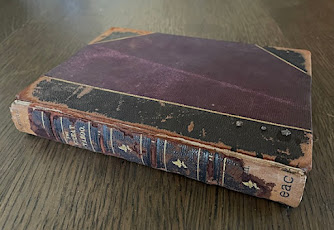Jan Hilliard [Hilda Kay Grant]
New York: Abelard -Schuman, 1960
247 pages
Miranda is the mother of two daughters, the younger being Rose, the narrator of this novel. Rose calls her mother Miranda, as encouraged by Miranda because Miranda would rather be taken for an older sister.
Miranda has aspirations. She married Alfie Arnold with the expectation that he would raise her above the class into which she'd been born. They are a good match – he loves her dearly, she really loves him –except that Alfie is content with living a modest life on his aunt's small Sussex farm. Miranda will have none of it. At her urging, the family is uprooted, trading Aunt Eliza's farm for a much larger one in Nova Scotia's Annapolis Valley. The Arnolds are able to do this only with the financial assistance of a Government of Canada program designed to bring agricultural labourers to the country. This is not to suggest that Miranda herself has any intention of working herself. She had her fill during the Great War, when she's served as a Park Lane parlourmaid. Again, Miranda has aspirations:
The Arnolds spend three years in Cheswick, living in a small house on the farm of Mr and Mrs Saunders. Alfie, a cheerful soul by nature, is happier than he's ever been. Not so Miranda. In Canada, she'd expected her family would "stand out like a pearl among the stones," but the locals take no particular notice. The farming couple's warmth and friendliness, so appreciated by Alfie and the girls, only serves to irritate. One particular Sunday road trip to Grande Pré, complete with the recitation of select lines from Evangeline and an account of the Acadian Expulsion, was almost too much for Miranda to bear. And then came Mrs Saunders' offer, filled "with such enthusiasm and goodwill," to teach Miranda Canadian ways and customs:
"Why should I learn their damned customs?" Miranda demanded as soon as she got my father home. The story of Evangeline had not gone over too well with her. She suspected Mrs. Saunders was being anti-British. "What's the matter with English customs?
"She was only trying to help," Alfie said in a placating voice.
"Saying she'd make real Canadians out of us in no time! I never heard of anything so insulting. I didn't come to the colonies to be one of them."
Miranda avoids Mrs Saunders, but does enjoy the company Dan Murphy, District Representative of veterinary supply firm B.F. Whitney. Whether the salesman sees Miranda as a pearl among the stones is debatable, but he does drop by from time to time, always when Alfie is in the fields. Dan strokes her amour propre, but nothing more. Through the salesman, Miranda gets the idea that Alfie himself might find a district representative position with B.F. Whitney. She prods, eventually applying to the company on her husband's behalf and Alfie is quickly hired. At about the same time his Aunt Eliza kicks the washtub, leaving an inheritance of £200 (roughly $16,000 today).
"'My husband has fallen heir to his aunt's estate in Sussex,'" Rose hears Miranda tell Mrs Saunders. "She made poor old Great-aunt Eliza, who used to wear men's boots indoors and out and took her baths standing up at the sink in the scullery, sound like an offshoot of royalty."
The family relocates to Yarmouth – "which I shall call Southport" – the biggest town in Alfie's district. This raised concern in this reader, who well-remembers grade six geography class.
Herein lies the problem. There's not much call for veterinary supplies in an area so reliant on fishing. The land is poor and the farms hardscrabble. Alfie is miserable, casting about for customers, as his inheritance evaporates. Miranda tries to help by working part-time at Betty's Beauty Parlor, but all too quickly Alfie's position at The B.F. Whitney Company quite literally kills him.
Miranda is devastated – again, she really did love Alfie – yet has the strength to rally. She takes in roomers and increases her hours at Betty's.* The job feeds her ego. After all, who better to work in a beauty salon than the town beauty? Without Alfie to rely upon, she reveals herself as a very clever woman, adding layer after layer to her facade, never being caught out on one of her many, many fabrications.
 |
| The Calgary Herald, 11 May 1961 |
This is, of course, Miranda's story, but only as seen by her youngest. As she grows into womanhood, Rose gradually comes to see – and then comes to terms – with not only her mother's imperfections, but how she is perceived, fairly or not, by others.
Reviews of Miranda were without exception enthusiastic; Walter O'Hearne raved in The New York Times (16 April 1961), as did fellow Leacock winner Joan Walker in The Globe & Mail (1 July 1961). Not that any of this meant anything in the long run.
Sadly, unfairly, Miranda is yet another novel that was printed once and then never again. In this respect, it is very much a pearl among the stones.
Will a publisher please pick it up?
About the author:
Object and Access: A butter-coloured cloth hardcover with violet type. I'm guessing that the jacket illustration is the author's own doing, though I could be wrong.
I'm pleased to see that Yarmouth's Izaak Walton Killam Memorial Library has copies of all the author's books.
As of this writing, I see just one copy listed for sale online. Near Fine, at US$9.25, it's a steal. The seller is located in Greenwood, Nova Scotia, which I shall call Cheswick.
































